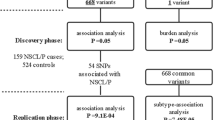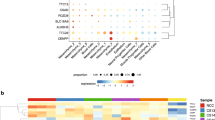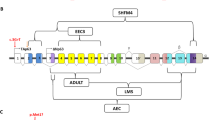Abstract
The prevalence of nonsyndromic cleft lip with or without cleft palate (CL/P) and cleft palate only (CPO) are believed to be higher in the Japanese than in Americans, Europeans or Africans. The purpose of this study was to investigate, in a Japanese population, relationships between CL/P or CPO and seven candidate genes (TGFB3, DLX3, PAX9, CLPTM1, TBX10, PVRL1, TBX22) that showed positive associations in other populations and are expressed in the oral/lip region in developing mice. We first searched for mutations in these genes among 112 CL/P and 16 CPO patients, and found a heterozygous missense mutation (640A>G, S214G) in exon 3 of PAX9 in two sibs with CL/P and their phenotypically normal mother from a Japanese family. A population-based case-control analysis and a family-based transmission disequilibrium test (TDT), using single nucleotide polymorphisms (SNPs), and two-SNP haplotypes of the genes, between the 112 CL/P cases with their parents and 192 controls indicated a significant association at one SNP site, IVS1+5321, in TGFB3 with a P-value of 0.0016. Population-based haplotyping revealed that the association was most significant for haplotype “A/A” consisting of IVS1+5321 and IVS1−1572; TDT also gave a P-value of 0.0252 in this haplotype.
Similar content being viewed by others
Log in or create a free account to read this content
Gain free access to this article, as well as selected content from this journal and more on nature.com
or
References
Badano JL, Katsanis N (2002) Beyond Mendel: an evolving view of human genetic disease transmission. Nat Rev Genet 3:779–789
Beaty TH, Hetmanski JB, Zeiger JS, Fan YT, Liang KY, VanderKolk CA, McIntosh I (2002) Testing candidate genes for non-syndromic oral clefts using a case-parent trio design. Genet Epidemiol 22:1–11
Braybrook C, Doudney K, Marcano AC, Arnason A, Bjornsson A, Patton MA, Goodfellow PJ, Moore GE, Stanier P (2001) The T-box transcription factor gene TBX22 is mutated in X-linked cleft palate and ankyloglossia. Nat Genet 29:179–183
Braybrook C, Lisgo S, Doudney K, Henderson D, Marcano AC, Strachan T, Patton MA, Villard L, Moore GE, Stanier P, Lindsay S (2002) Craniofacial expression of human and murine TBX22 correlates with the cleft palate and ankyloglossia phenotype observed in CPX patients. Hum Mol Genet 11:2793–2804
Bryan JT, Morasso MI (2000) The Dlx3 protein harbors basic residues required for nuclear localization, transcriptional activity and binding to Msx1. J Cell Sci 113:4013–4023
Bush JO, Lan Y, Jiang R (2004) The cleft lip and palate defects in Dancer mutant mice result from gain of function of the Tbx10 gene. Proc Natl Acad Sci USA 101:7022–7027
Bustos T, Simosa V, Pinto-Cisternas J, Abramovits W, Jolay L, Rodriguez L, Fernandez L, Ramela M (1991) Autosomal recessive ectodermal dysplasia: I. An undescribed dysplasia/malformation syndrome. Am J Med Genet 41:398–404
Carinci F, Pezzetti F, Scapoli L, Martinelli M, Avantaggiato A, Carinci P, Padula E, Baciliero U, Gombos F, Laino G, Rullo R, Cenzi R, Carls F, Tognon M (2003) Recent developments in orofacial cleft genetics. J Craniofac Surg 14:130–143
Cobourne MT (2004) The complex genetics of cleft lip and palate. Eur J Orthod 26:7–16
Das P, Stockton DW, Bauer C, Shaffer LG, D’Souza RN, Wright T, Patel PI (2002) Haploinsufficiency of PAX9 is associated with autosomal dominant hypodontia. Hum Genet 110:371–376
Das P, Hai M, Elcock C, Leal SM, Brown DT, Brook AH, Patel PI (2003) Novel missense mutations and a 288-bp exonic insertion in PAX9 in families with autosomal dominant hypodontia. Am J Med Genet A 118:35–42
Freedman ML, Reich D, Penney KL, McDonald GJ, Mignault AA, Patterson N, Gabriel SB, Topol EJ, Smoller JW, Pato CN, Pato MT, Petryshen TL, Kolonel LN, Lander ES, Sklar P, Henderson B, Hirschhorn JN, Altshuler D (2004) Assessing the impact of population stratification on genetic association studies. Nat Genet 36:388–393
Jezewski PA, Vieira AR, Nishimura C, Ludwig B, Johnson M, O’Brien SE, Daack-Hirsch S, Schultz RE, Weber A, Nepomucena B, Romitti PA, Christensen K, Orioli IM, Castilla EE, Machida J, Natsume N, Murray JC (2003) Complete sequencing shows a role for MSX1 in non-syndromic cleft lip and palate. J Med Genet 40:399–407
Juriloff DM, Harris MJ, Brown CJ (2001) Unravelling the complex genetics of cleft lip in the mouse model. Mamm Genome 12:426–435
Kim MH, Kim HJ, Choi JY, Nahm DS (2003) Transforming growth factor-beta3 gene SfaN1 polymorphism in Korean nonsyndromic cleft lip and palate patients. J Biochem Mol Biol 36:533–537
Kondo S, Schutte BC, Richardson RJ, Bjork BC, Knight AS, Watanabe Y, Howard E, de Lima RL, Daack-Hirsch S, Sander A, McDonald-McGinn DM, Zackai EH, Lammer EJ, Aylsworth AS, Ardinger HH, Lidral AC, Pober BR, Moreno L, Arcos-Burgos M, Valencia C, Houdayer C, Bahuau M, Moretti-Ferreira D, Richieri-Costa A, Dixon MJ, Murray JC (2002) Mutations in IRF6 cause Van der Woude and popliteal pterygium syndromes. Nat Genet 32:285–289
Kraus P, Lufkin T (1999) Mammalian Dlx homeobox gene control of craniofacial and inner ear morphogenesis. J Cell Biochem 32–33[Suppl]:133–140
Law DJ, Garvey N, Agulnik SI, Perlroth V, Hahn OM, Rhinehart RE, Gebuhr TC, Silver LM (1998) TBX10, a member of the Tbx1-subfamily of conserved developmental genes, is located at human chromosome 11q13 and proximal mouse chromosome 19. Mamm Genome 9:397–399
Lidral AC, Murray JC, Buetow KH, Basart AM, Schearer H, Shiang R, Naval A, Layda E, Magee K, Magee W (1997) Studies of the candidate genes TGFB2, MSX1, TGFA, and TGFB3 in the etiology of cleft lip and palate in the Philippines. Cleft Palate Craniofac J 34:1–6
Marcano AC, Doudney K, Braybrook C, Squires R, Patton MA, Lees MM, Richieri-Costa A, Lidral AC, Murray JC, Moore GE, Stanier P (2004) TBX22 mutations are a frequent cause of cleft palate. J Med Genet 41:68–74
Mitchell LE, Beaty TH, Lidral AC, Munger RG, Murray JC, Saal HM, Wyszynski DF (2002) International consortium for oral clefts genetics. Guidelines for the design and analysis of studies on nonsyndromic cleft lip and cleft palate in humans: summary report from a workshop of the international consortium for oral clefts genetics. Cleft Palate Craniofac J 39:93–100
Natsume N, Kawai T, Kohama G, Teshima T, Kochi S, Ohashi Y, Enomoto S, Ishii M, Nakano Y, Matsuya T, Kogo M, Yoshimura Y, Ohishi M, Nakamura N, Katsuki T, Goto M, Shimizu M, Yanagisawa S, Mimura T, Sunakawa H (2000) Incidence of cleft lip or palate in 303738 Japanese babies born between 1994 and 1995. Br J Oral Maxillofac Surg 38:605–607
Papaioannou VE, Silver LM (1998) The T-box gene family. Bioessays 20:9–19
Peters H, Neubuser A, Kratochwil K, Balling R (1998) Pax9-deficient mice lack pharyngeal pouch derivatives and teeth and exhibit craniofacial and limb abnormalities. Genes Dev 12:2735–2747
Prescott NJ, Lees MM, Winter RM, Malcolm S (2000) Identification of susceptibility loci for nonsyndromic cleft lip with or without cleft palate in a two stage genome scan of affected sib-pairs. Hum Genet 106:345–350
Price JA, Bowden DW, Wright JT, Pettenati MJ, Hart TC (1998) Identification of a mutation in DLX3 associated with tricho-dento-osseous (TDO) syndrome. Hum Mol Genet 7:563–569
Proetzel G, Pawlowski SA, Wiles MV, Yin M, Boivin GP, Howles PN, Ding J, Ferguson MW, Doetschman T (1995) Transforming growth factor-beta 3 is required for secondary palate fusion. Nat Genet 11:409–414
Purcell S, Cherny SS, Sham PC (2003) Genetic power calculatior: design of linkage and association genetic mapping studies of complex traits. Bioinformatics 19:149–150
Sato F, Natsume N, Machido J, Suzuki S, Kawai T (2001) Association between transforming growth factor beta 3 and cleft lip and/or palate in the Japanese population. Plast Reconstr Surg 107:1909–1910
Schutte BC, Murray JC (1999) The many faces and factors of orofacial clefts. Hum Mol Genet 8:1853–1859
Sozen MA, Suzuki K, Tolarova MM, Bustos T, Fernandez Iglesias JE, Spritz RA (2001) Mutation of PVRL1 is associated with sporadic, non-syndromic cleft lip/palate in northern Venezuela. Nat Genet 29:141–142
Stockton DW, Das P, Goldenberg M, D’Souza RN, Patel PI (2000) Mutation of PAX9 is associated with oligodontia. Nat Genet 24:18–19
Suzuki K, Hu D, Bustos T, Zlotogora J, Richieri-Costa A, Helms JA, Spritz RA (2000) Mutations of PVRL1, encoding a cell–cell adhesion molecule/herpes virus receptor, in cleft lip/palate-ectodermal dysplasia. Nat Genet 25:427–430
Takeuchi T, Kuro-o M, Miyazawa H, Ohtsuki Y, Yamamoto H (1997) Transgenic expression of a novel thymic epithelial cell antigen stimulates abberant development of thymocytes. J Immunol 159:726–733
Tanabe A, Taketani S, Endo-Ichikawa Y, Tokunaga R, Ogawa Y, Hiramoto M (2000) Analysis of the candidate genes responsible for non-syndromic cleft lip and palate in Japanese people. Clin Sci 99:105–111
Van den Boogaard MJ, Dorland M, Beemer FA, van Amstel HK (2000) MSX1 mutation is associated with orofacial clefting and tooth agenesis in humans. Nat Genet 24:342–343
Vanderas AP (1987) Incidence of cleft lip, cleft palate, and cleft lip and palate among races: a review. Cleft Palate J 24:216–225
Yoshiura K, Machida J, Daack-Hirsch S, Patil SR, Ashworth LK, Hecht JT, Murray JC (1998) Characterization of a novel gene disrupted by a balanced chromosomal translocation t(2;19)(q11.2;q13.3) in a family with cleft lip and palate. Genomics 54:231–240
Wyszynski DF, Maestri N, McIntosh I, Smith EA, Lewanda AF, Garcia-Delgado C, Vinageras-Guarneros E, Wulfsberg E, Beaty TH (1997) Evidence for an association between markers on chromosome 19q and non-syndromic cleft lip with or without cleft palate in two groups of multiplex families. Hum Genet 99:22–26
Zucchero TM, Cooper ME, Maher BS, Daack-Hirsch S, Nepomuceno B, Ribeiro L, Caprau D, Christensen K, Suzuki Y, Machida J, Natsume N, Yoshiura K, Vieira AR, Orioli IM, Castilla EE, Moreno L, Arcos-Burgos M, Lidral AC, Field LL, Liu YE, Ray A, Goldstein TH, Schultz RE, Shi M, Johnson MK, Kondo S, Schutte BC, Marazita ML, Murray JC (2004) Interferon regulatory factor 6 (IRF6) gene variants and the risk of isolated cleft lip or palate. N Engl J Med 351:769–780
Acknowledgements
The participation of patients, their families and control individuals in the study is greatly appreciated. We also thank staff members of Tokyo Dental College Hospital and Nagasaki University Hospital who assisted in collecting blood samples and those of the Department of Human Genetics at Nagasaki University for excellent technical assistance. K. Yoshiura was supported in part by a Grant-in-Aid for Scientific Research on Priority Areas (Medical Genome Science, No. 16012101); N. Niikawa by a Grant-in-Aid for Scientific Research (Category S, No. 13854024) and CREST from the Japan Science and Technology Agency Corporation (JST).
Author information
Authors and Affiliations
Corresponding author
Rights and permissions
About this article
Cite this article
Ichikawa, E., Watanabe, A., Nakano, Y. et al. PAX9 and TGFB3 are linked to susceptibility to nonsyndromic cleft lip with or without cleft palate in the Japanese: population-based and family-based candidate gene analyses. J Hum Genet 51, 38–46 (2006). https://doi.org/10.1007/s10038-005-0319-8
Received:
Accepted:
Published:
Issue date:
DOI: https://doi.org/10.1007/s10038-005-0319-8
Keywords
This article is cited by
-
The effect of sevoflurane on developing A/J strain mouse embryos using a whole-embryo culture system—the incidence of cleft lip in culture embryos
In Vitro Cellular & Developmental Biology - Animal (2014)
-
Systematic analysis of palatal transcriptome to identify cleft palate genes within TGFβ3-knockout mice alleles: RNA-Seq analysis of TGFβ3 Mice
BMC Genomics (2013)
-
Intra-amniotic Transient Transduction of the Periderm With a Viral Vector Encoding TGFβ3 Prevents Cleft Palate in Tgfβ3−/− Mouse Embryos
Molecular Therapy (2013)
-
Maternal transmission effects of the PAX genes among cleft case–parent trios from four populations
European Journal of Human Genetics (2009)
-
TGFB3 displays parent-of-origin effects among central Europeans with nonsyndromic cleft lip and palate
Journal of Human Genetics (2008)



